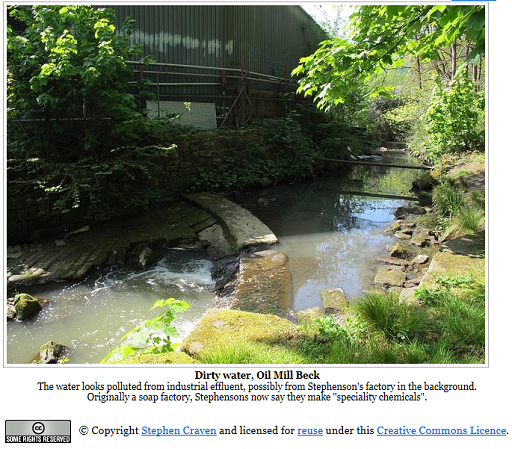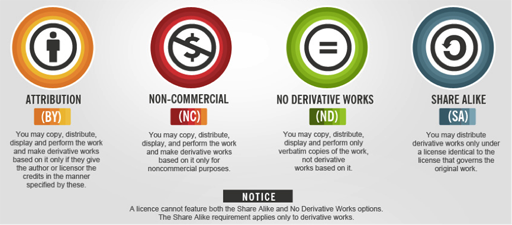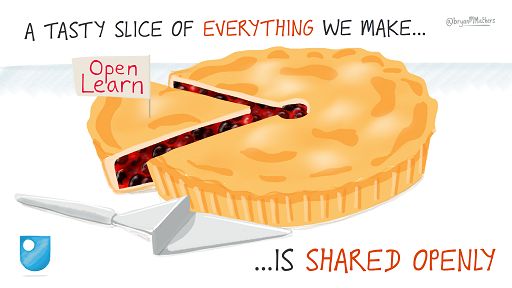Use 'Print preview' to check the number of pages and printer settings.
Print functionality varies between browsers.
Printable page generated Saturday, 22 November 2025, 1:31 AM
4 Using existing free content
Introduction
In this session you will consider the reasons why you may want to reuse existing open content in your course. You will learn about how best to find this content, and how to ensure that you are allowed to due to copyright.
Listen to the following audio recording in which Rosie Storrar introduces the session.
Transcript: 4 Using existing free content
4.1 Why reuse other open content in your course?
Rather than producing new material completely from scratch, incorporating existing content into your course can save time and money. Existing material may provide depth and breadth of examples or experience to complement the ideas and material you can write about. You can enrich and improve your course with existing material, especially if you have no budget for creating audiovisual materials.
Material with an open licence brings the additional benefit of being able to reuse it at low or no cost, depending on the terms of the licence. Open content is often openly peer-reviewed during its creation, especially if created using a collaborative process, which increases its quality and the extent to which it supports learning.
Your initial plans for the course and approach to OER might be that you expect to copy and paste without adapting or create material from scratch. You may have the idea that it is somehow ‘wrong’ to adapt content for your specific context, that it should be used without change or not used at all. However if existing content you would like to use cannot be altered to suit the context and the needs of the audience then potentially you will end up with a poorer quality course. For example, you may need to adapt the language or level of a piece of highly technical writing which provides a really useful perspective on the topic to make it more accessible for school aged learners.
Being able to identify whether the material you decide to reuse or remix is licenced for adaption (so doesn’t have a licence including the words ‘non-derivative’) and planning properly for the effort and benefits of adapting existing content is essential.
4.2 Creative Commons licensing
This section describes the most common form of open licence: the Creative Commons set of licences.
Creative Commons licensing lets you know how the original author would like their material to be reused, while they retain the copyright.
Other open courses have explained the creative commons licence system very well, so rather than repeat their guidance in this course we suggest you explore the following for concise explanations about open licences, why they are used and how to use them:
For reference, the main types of CC licence, which can be combined, are as follows (see also Figure 1):
- Attribution (BY) – You may copy, distribute, display and perform the work and make derivative works based on it only if they give the author or licensor the credits in the manner specified by these.
- Non-Commercial (NC) – You may copy, distribute, display and perform the work and make derivative works based on it only for noncommercial purposes.
- No Derivative Works (ND) – You may copy, distribute, display and perform only verbatim copies of the work, not derivative works based on it.
- Share Alike (SA) – You may distribute derivative works only under a license identical to the license that governs the original work.
Note that a licence cannot feature both the Share Alike and No Derivative Works options. The Share Alike requirement applies only to derivative works.
4.3 Identifying OER content on other sites to reuse
There is so much openly licensed content on the internet, covering most subject areas on a vast array of websites that the choice may be bewildering. Using a search tool to narrow down the choice to material which has been licensed for reuse can help save time re-creating something required in the course. Some sites or search tools offer a search which looks across several sites for material, such as Solvonauts. OpenLearn and OpenLearn Create use a Google custom search to help you find material which is published on each site, in future OpenLearn Create will also offer a Google custom search similar to that on the Opening Educational Practices in Scotland hub, a website about open educational practice, which searches other sites for reusable material.
Some search engines, for example Google, provide tools to help you narrow down the results to only public domain or creative commons licensed materials, rather than ‘all rights reserved’ (which would require permission to use and possibly a fee). In the Google search you select ‘search tools’ and ‘usage rights’ then select the appropriate licence option from the list to narrow your search to materials you can reuse.
Some repository sites collect licence information from users when material is uploaded. This metadata is used to inform the filter on the search. For example, on Flickr (the photographic repository), information appears the dropdown filter about what the licence allows you to do, for example ‘modifications allowed’ or ‘no known copyright restrictions’, rather than using the licence name. This helps you select an option quickly. Once an image is selected, the licence information (for example ‘some rights reserved’) is displayed with the other metadata about the image and the site links to the licence type and legal description.
4.4 A bit about OpenLearn ...
All the courses on the Open University’s OpenLearn platform carry a Creative Commons licence and can be reused. Some assets within OpenLearn courses may be All Rights Reserved as the university has paid for the rights to use them within its courses. If you want to use an OpenLearn course which contains some All Rights Reserved assets you would need to contact the licence holder to get permission to reuse those assets in your course.
4.5 Using YouTube and open syndication principles
Creating an open online course in a specific environment for an expected audience is a challenging and rewarding activity, especially if you are close to and enthused by the subject matter. While we have expressed the importance of knowing your audience through you writing, your platform of delivery may not necessarily reach that group outside of any targeted promotional activity. If you are keen for different groups and demographics to find your content it is worth considering how you syndicate your course. By syndication, we mean that your course, and/or the assets within in, can be published onto other channels with different demographics and reach.
For example, one of the key requests from learners declaring a disability who use the OpenLearn platform is to have content available in multiple formats. For this reason, each course on OpenLearn is provided in epub, Word and PDF for use on multiple devices. These formats, once created, are also syndicated to Amazon (for Kindle users), Google Play and iTunesU, still carrying the Creative Commons licence and still for free. Similarly with video and audio assets created by The Open University, these are syndicated to YouTube and iTunesU as the groups who use these platforms are different from those using OpenLearn. In considering a syndication approach to the content you are making, you can reach other groups and ensure that your course is as accessible as it can be.
4.6 Length of audio and video assets
Shorter audio-visual material works better. Longer pieces quickly lose a learner’s attention. Research indicates that the optimum video length in an open online course is two and a half minutes. It certainly isn’t recommended to exceed five minutes.
Therefore if you have plans for including a long video in your course you are advised to break it into a series of short videos, perhaps with text in between videos to introduce each piece and the concepts it explores. You can also use this as an opportunity to raise particular points you want learners to look out for as they watch the video and provide short discussions to read after they have viewed the video. Please refer to Session 2 for examples.
4.7 Remixing OER to include in your course
The following activity is copied from an openly licensed short course on OpenLearn An introduction to Open Educational Resources (OER). It neatly illustrates the process you need to go through to redesign existing OER to suit your specific purposes. You can choose to do this optional activity now or think about the implications of what is involved as you read it.
Activity 1
- Find some OER material that interests you, or that you think you might like to develop. It could be on a topic you know about, or something completely new.
- Decide who your learners are – what they already know (if anything) about the topic you’ve chosen, what might get them interested. (You may need to cycle through these first two bullet points a few times, before you settle on some material and some learners.)
- Now that you’ve found the material, and have decided on your learners, set out what you see as the material’s strengths and weaknesses. What is missing? Does it go into too much detail, or not enough? If the material is on a topic that is completely new to you, you can test it against your own requirements: does it help you learn?
- Find or suggest some new content – and explain what this adds to the existing material, and why you feel it will be useful and relevant for your learners.
Discussion
When working through this process of finding OER to reuse you would be evaluating material you find to decide whether it is relevant and usable for your purpose. On good sites there would be ratings and review tools which might inform your views on the viability of material you consider for reuse. It is unlikely that you will reuse an entire course in your material, you’re more likely to pick and choose relevant pieces which translate well into your context and this will inevitably result in writing contextual information to frame an activity or a piece of information. So although finding and reusing OER saves time creating something from scratch, you still need to allow time for critical evaluation of the material you find and possibly some re-writing.
4.8 Managing open assets
You must remember to keep records of source material and licence information, so that you can provide the correct attribution to anything you reuse in the acknowledgements page of your course. Using an asset register is a good way to keep track of everything you want to include in your course, both the materials you create and those which come from third parties. A typical asset register, in spreadsheet form, would include headings for the following:
- asset number (used to identify location of an asset in course materials)
- name/title of asset (this can be used to describe the asset)
- long description (particularly useful for describing images and diagrams)
- file type (e.g. PDF, jpg, doc, ppt, xls, audio or video file)
- filename (e.g. DCN1234.jpg)
- source URL (where you found the OER online)
- location(s) in course (in which section / subsection / week if this is an OER divided into weeks / activity / quiz)
- rights/third party (who owns the copyright - even if all the assets are owned by you or your organisation it is a good idea to record this in the asset register for the benefit of the person uploading the assets to the course)
- attribution to use with third party asset
- clearance approved to release asset as Creative Commons (you can use this for notes about the clearance and date of clearance)
- URL in the course (URL for where the asset will appear in the course)
- acknowledgements to be included in the course (what needs to be listed about this asset on the acknowledgements page if the item belongs to a third party or if the organisation releasing the course wishes to retain ‘All rights reserved’ rather than use a Creative Commons licence for this asset)
- actions (a place for you to record any actions/notes about the asset).
Keeping an asset register up to date will ultimately save time especially as you enter the final phase of production and are uploading materials to the online platform. It will also help protect you from facing legal problems: if you want to reuse material which is All Rights Reserved you will be able to identify quickly from looking at the asset register that rights clearance for some assets is outstanding and needs to be resolved before you can make your course live.
Not every asset you find will have the attribution information clearly displayed. It may be necessary to piece together what might be the right attribution for the material. For example, the licence may be displayed in one place, the title in another and the owner in a different place. An image or piece of text you found on a blog may involve picking the caption of an image, or the title of the blog piece, the name of the owner from ‘about’ and the licence information from a side bar. Some websites or blogs will have this information helpfully with the image.

Once you have cleared the rights on assets which are All Rights Reserved (this might mean you pay a fee to the rights holder) you must provide appropriate attribution on the Acknowledgements page of your course. Some useful phrases to introduce all the third party assets include:
The following materials in this course are All Rights Reserved. Please apply to the copyright holder to reuse these materials.
The content acknowledged below is Proprietary and used under licence (not subject to Creative Commons licence). See terms and conditions. Grateful acknowledgement is made to the following: (followed by a list of third party assets and where they have been used in your course)
On the Acknowledgements page you could also include the following statement (if it is true):
Every effort has been made to contact copyright holders. If any have been inadvertently overlooked, the publishers of this course will be pleased to make the necessary arrangements at the first opportunity.
You also need to declare the open licence you are using for the course, and how you would like people to reference the course. The following statement can be used:
Except for third party materials and otherwise stated in the acknowledgements section, this content is made available under a [specific Creative Commons Licence]
You would insert the licence you have chosen for your course – it is usual to provide a link to the licence on the Creative Commons website.
You could also provide a specific citation format for your course for others to use when they attribute where they found OER they’ve reused, for example the attribution for this course is:
How to make an open online course, The Open University [URL] [licence], 2016
This makes it easy for people to attribute your course when they use it, encouraging good open educational practice. There are benefits to feeding back to authors that you have reused something they released openly as it provides them with evidence that their material is having an impact in the open. It is good practice to send the original authors a message about what you have created which has included their materials, you could do this by commenting on the source material (if commenting is possible), using social media to tag the author about your course or send an email.
4.9 Summary
In this session of the course you have learned how to incorporate free existing content in your course. Additionally, you have learned about the Creative Commons license, which is a fundamental point to consider when writing an open online course.
In the next session you will be given some good practice advice on how to write your course content and learn about the importance of having an editor review your work. You will also be given some guidance on how to create audio and video assets. In the next session, you will be given an opportunity to test your learning in a practice quiz.
You can now go to Session 5.
Acknowledgements
This session of the course was written by Anna Page on behalf of the Free Learning team at The Open University.
Except for third party materials and otherwise stated (see terms and conditions), this content is made available under a Creative Commons Attribution-NonCommercial-ShareAlike 4.0 Licence.
Images
Figure 1: Source: How to Attribute Creative Commons Photos, by FOTER, CC BY-SA 3.0
Figure 2: by Bryan Mathers http://bryanmathers.com/ CC BY ND
Figure 3: Stephen Craven CC-BY-SA-2.0 as displayed on http://www.geograph.org.uk/ photo/ 4999640
Every effort has been made to contact copyright owners. If any have been inadvertently overlooked, the publishers will be pleased to make the necessary arrangements at the first opportunity.

